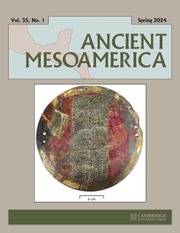Article contents
The rise, expansion, and endurance of Kaanul: The view from northwestern Peten
Published online by Cambridge University Press: 04 October 2024
Abstract
The ancient Maya political landscape was permeated by regional systems of political asymmetry. These hegemonic networks fluctuated through time, but the steady presence of a few especially dominant polities shows that they were a persistent feature with very real sociopolitical effects. Based on research carried out at the sites of La Corona and Achiotal, and epigraphic studies in many other sites in the Maya Central Lowlands, we offer a general interpretation of the historical and sociopolitical development of one of these hegemonic polities: the Kaanul dynasty. Combining epigraphic and archaeological data, we discuss the Early Classic political landscape in the northern Peten region (“Chatahn” Winik, Suutz', and Sak Wahyis), as well as the development and maintenance of political relations with the Kaanul dynasty for over two centuries. These data allow us to suggest that the northwestern Peten was not only a strategic point for the initial expansion of the Kaanul dynasty in the sixth century a.d., but also an important lynchpin for the maintenance of its hegemonic control in the seventh and eighth centuries a.d. We suggest that epigraphic and archaeological data of the northern Peten from the Classic period help to illuminate how a unique regional hegemony over the Maya Lowlands was achieved and maintained.
Resumen
El paisaje geopolítico de las tierras bajas mayas durante el período clásico se caracterizó por sistemas regionales de asimetría política. Estos sistemas fluctuaron a lo largo del tiempo, pero algunas entidades fueron más estables y dominantes en períodos considerables, por lo que causaron efectos sociopolíticos en toda la región. Con base en las investigaciones llevadas a cabo en La Corona y Achiotal, así como datos epigráficos de otros sitios de las tierras bajas mayas, se ha reconstruido el desarrollo histórico y sociopolítico de la dinastía Kaanul del período clásico, que se identificó por un glifo emblema cuyo signo principal fue una cabeza de serpiente.
A pesar de que se ha propuesto que los Kaanul tuvieron su primera sede dinástica en la región de El Mirador durante el período preclásico, dichas evidencias son ambiguas y todas pertenecen al período clásico. Además, según las evidencias más recientes, se considera que la sede original de dicha dinastía fue Dzibanché, cuyo nombre original fue Kaanul. Combinando datos epigráficos y arqueológicos, también se discute la presencia de varias entidades políticas en la región noroccidental de Petén a inicios del clásico temprano: “Chatahn” Winik, Suutz', y Sak Wahyis. Se propone que “Chatahn” fue el nombre de un lugar o entidad política que abarcaba la región entre Calakmul, El Mirador y Achiotal, la que fue parcialmente controlada por los Suutz' en el siglo cuarto. Por otro lado, también se propone que Sak Wahyis identificó los gobernantes de la entidad política centrada en Sak Nikte', hoy conocida como La Corona.
Durante el siglo quinto, la dinastía Kaanul inició una serie de conquistas y alianzas que culminó en el establecimiento de una relación muy cercana con los Sak Wahyis, la cual duró más de dos siglos. De igual forma, los Kaanul coexistieron con los “Chatahn” Winik y Suutz' en Calakmul y toda la región norte de Petén, creando así un régimen político novedoso y exitoso, que desarrolló una forma de coerción pasiva que incluyó diversas formas de relaciones políticas.
Los datos de La Corona indican que el noroccidente de Petén fue un punto estratégico para la expansión inicial de Kaanul y clave para mantener el control hegemónico de un área extensa en los siglos séptimo y octavo. Sitios “menores”, “secundarios” o “satélites” como La Corona permitieron conectar físicamente todo el territorio a través de una red de caminos, pero también fueron unificados ideológicamente, a través de un conjunto de identidades políticas heterogéneas. Los Kaanul permitieron, incorporaron e incluso dependieron de una autonomía preexistente en cada región. Por lo tanto, el estado hegemónico Kaanul, especialmente el desarrollado por Yuknoom Ch'een II, fue una acumulación de componentes políticos, económicos, religiosos y sociales de las regiones conquistadas y absorbidas, lo cual se expresó en estrategias de subsistencia, prácticas y creencias religiosas, relaciones de parentesco e instituciones políticas.
Information
- Type
- Research Article
- Information
- Copyright
- Copyright © The Author(s), 2024. Published by Cambridge University Press
Footnotes
This work has not been published elsewhere, in whole or in part, nor is it under consideration for publication elsewhere
References
- 4
- Cited by


